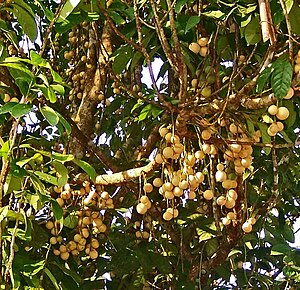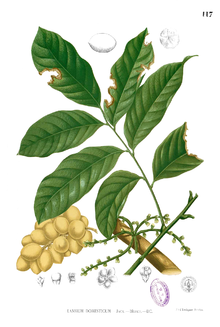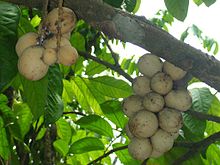Lansi tree
| Lansi tree | ||||||||||||
|---|---|---|---|---|---|---|---|---|---|---|---|---|

Lansi tree ( Lansium domesticum ) |
||||||||||||
| Systematics | ||||||||||||
|
||||||||||||
| Scientific name | ||||||||||||
| Lansium domesticum | ||||||||||||
| Corrêa |
The lansi tree ( Lansium domesticum ) is a species of the mahogany family (Meliaceae). It probably originally comes from Malaysia and is hardly known in Europe, but its fruits are very popular in the Philippines , Thailand , Malaysia and Indonesia and are also cultivated in South India and Sri Lanka .
features
Vegetative characteristics
The lansi tree is a slow-growing, medium-sized tree that needs shade and will bear fruit after 7 to 10 years. It reaches heights of growth of up to 30 meters, in culture mostly only about 4 meters. The trunk is fluted at the base or buttress roots are formed. The bark is slightly scaly and gray to reddish brown. The short-stemmed tree has a sticky milky sap .
The stalked and alternately paired or incorrectly unpaired pinnate, 30 to 50 cm long, bare and leathery leaves are alternate . The 8 to 20 somewhat leathery, up to 25 cm long, conspicuously veined leaflets are elliptical to obovate , with entire margins and pointed or pointed to tailed, glabrous and shiny on the top and dull, lighter and hairy on the underside. Stipules are missing. Pulvini may be present on the petioles .
Generative characteristics
The small, mostly hermaphrodite , cream-colored, short-stalked, fivefold flowers grow in caulifloren or ramifloren to 20 cm long grapes that appear in groups on the trunk or thick branches, rarely on branches, they are finally suspended initially upright and development of the fruit . From one inflorescence 6 to 20, sometimes up to 30 fruits develop. There are minimal cover sheets . The cup-shaped calyx is short and five-lobed. The ten, short stamens are fused into a fleshy tube. The Upper constant, hairy ovary has a wide haired pen .
The spherical, light yellow-brownish, mostly smooth berry has a diameter of 2 to 4 cm, it contains up to five seeds that are covered with juicy, glassy-white seed coats ( arilli ). Only one to three of them contain a complete seed (core). The seed coats usually taste sweet and sour; especially the thin skin that surrounds the core and the core are very bitter in some varieties. The undeveloped compartments are filled with aril tissue. The elliptical, flat seeds are up to 13 millimeters long without aril, with aril they are 25 millimeters in size. The white, thin pericarp sometimes contains more or less milky juice.
The number of chromosomes is 2n = 144.
Systematics
The first description of the species by the Portuguese botanist José Francisco Corrêa da Serra was published in 1807. Numerous synonyms are known.
More recent analyzes have shown that all previously propagated varieties or subspecies are only races and cultivars of one species.
use
The fruits are eaten raw or cooked. The dried fruit peel can be used as a fragrant incense against insects or against diseases.
The durable wood is used in Java for building houses.
The fruit, but also the bark of the tree, its leaves and the bitter seed core are also used for medicinal purposes.
In the south of Thailand and the province of Uttaradit a cultivar is grown, Longkong ( Thai : ลองกอง , spoken lO: ng gO: ng ), which is very sweet and aromatic, without the sour part of another cultivar, Langsat (Thai: ลางสาด , spoken la: ng sà: d ) means. In addition, the Longkong variety has only a few, sometimes even no seeds, and is characterized by a thin shell with little resinous milky juice. Filipino Cultivars; Lancones , also Lansones or Lanzones, have a hard, yellow-brown, weakly grained skin, spherical fruit with a split brown and very bitter core. In Indonesia and Malaysia; On the island of Sumatra , among others , the fruit is commonly referred to as duku or lanseh .
Dried and ground bark is given as an astringent tea for dysentery and malaria .
The milky sap is used medicinally and in arrow poisons .
literature
- DJ Mabberley, CM Pannell, AM Sing: Flora Malensia. Ser. 1, Vol. 12, Pt. 1, 1995, pp. 314-322, online at biodiversitylibrary.org, accessed October 24, 2018.
- TK Lim: Edible Medicinal And Non Medicinal Plants. Volume 3: Fruits , Springer, 2012, ISBN 978-94-007-2533-1 , pp. 269-276.
Web links
- Entry at GRIN.
- Langsat Lansium domesticum at Purdue University (English).
- Lansium domesticum at Useful Tropical Plants, accessed October 24, 2018.
Individual evidence
- ↑ Ann. Mus. Hist. Nat. Paris 10: 157, t. 10, fig. 1, 1807. See entry at GRIN.
- ↑ TK Lim: p. 269.
- ↑ TK Lim: p. 276.
- ↑ Rolf Blancke: Color Atlas Exotic Fruits. Fruits and vegetables of the tropics and subtropics. Ulmer Verlag, Stuttgart 2000, ISBN 3-8001-3520-5 , p. 59.



